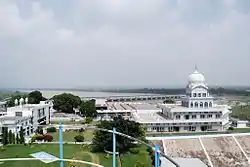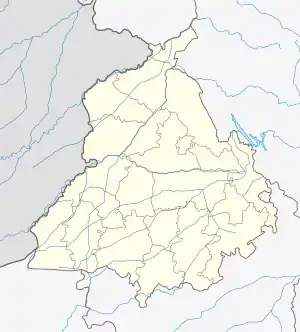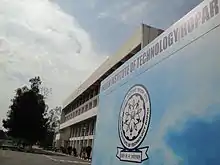Rupnagar
Rupnagar (/ˈrʊpnəɡər/; formerly known as Ropar) is a city and a municipal council in Rupnagar district in the Indian state of Punjab. Rupnagar is a newly created fifth Divisional Headquarters of Punjab comprising Rupnagar, Mohali, and its adjoining districts. It is also one of the bigger sites belonging to the Indus Valley Civilization. Rupnagar is nearly 43 km (27 mi) to the northwest of Chandigarh (the nearest airport and the capital of Punjab). It is bordered by Himachal Pradesh to the north and Shahid Bhagat Singh Nagar district (formerly known as Nawanshahr district) to its west.
Rupnagar
Ropar | |
|---|---|
City | |
 Gurudwara Tibbi Sahib situated on the banks of Satluj, Rupnagar. | |
| Nickname(s): Ropar | |
 Rupnagar  Rupnagar | |
| Coordinates: 30.9664°N 76.5331°E | |
| Country | |
| State | Punjab |
| District | Rupnagar |
| Established | 19th century (2000 BCE) |
| Government | |
| • Type | Municipal council |
| • Body | Ropar MC |
| Elevation | 262 m (860 ft) |
| Population (2011) | |
| • Total | 56,000 |
| Languages | |
| • Official | Punjabi |
| Time zone | UTC+5:30 (IST) |
| PIN | 140 001 |
| Telephone code | 91-1881 |
| Vehicle registration | PB-12 |
| Website | rupnagar |
There are many historical and religious places in Rupnagar, including gurdwaras such as Gurudwara Bhhatha Sahib and Gurudwara Tibbi Sahib.
History
Etymology
The ancient town of Rupnagar is said to have been named by a Gujjar Raja called Rokeshar, who ruled during the 11th century and named it after his son Rup Sen.
Indus Valley civilisation
%252C_Punjab%252C_India.jpg.webp)
Rupnagar is one of the Indus Valley sites along the Ghaggar-Hakra beds. There is an Archaeological Museum in the city which was opened in the year 1998 for general public. The museum exhibits the archaeological remains of excavated site in the city, the first Harappan site of Independent India. These excavations reveal a cultural sequence from Harappan to medieval times. Some of the important exhibits include antiquities of Harappan times, gold coins of Chandragupta and copper and bronze implements.[1] S. Hari Singh Rais of Sialba conquered Ropar in 1763 A.D. and established his state . S. Hari Singh son Charat Singh made Ropar capital of the state.

Geography
Rupnagar is located at 30.97°N 76.53°E.[2] It has an average elevation of 260 metres (850 ft). The town lies on the bank of Satluj River and the Shivalik hill range spreads along the opposite bank of the river.
Climate
The climate of Rupnagar is characterized by general dryness (except in the south west monsoon season), a hot summer and a cold winter. The year may be divided into four seasons. The period from about middle of November to February is the cold season. This is followed by the summer season from March to about the end of June. The south-west monsoon season commences late in June and continues up to about middle of September. The period from mid September to the middle of November constitutes the post-monsoon or transition season. The temperature ranges from a minimum of 1 °C (34 °F) in winter to 47 °C (117 °F) in summer. May and June are generally the hottest months and December and January are the coldest months. Relative humidity is high, averaging about 70% during monsoon. The average annual rainfall in the district is 775.6 millimetres (30.54 in). About 78% of the annual rainfall is received during June through September.[3]
Rupnagar wetland
%252C_Punjab.jpg.webp)
The city has one of the three important wetlands of the Punjab State known as Rupnagar Wetland or Ropar Wetland. This is a man-made freshwater wetland covering 1,365 hectares. Also called the Rupnagar Lake, the wetland developed consequent to the construction of a regulator on the Sutlej River.[4] The area has a large number of birds, mammals and vegetation. It has at least 9 mammalian, 154 bird, 35 fish, 9 arthropod, 11 rotifer and 10 protozoan species. This important ecological zone is located in the Shivalik foothills of the Lower Himalayas and was created in 1952 on the Sutlej River, in the Punjab state of India, by building a head regulator. The total area of the wetland is 1,365 hectares (3,370 acres). The wetland is surrounded by Shivalik hills to the northwest and by plains to the south and southeast.
Transport
Rail
Rupnagar railway station falls in the Northern Railway zone of the Indian Railways. It is connected to Chandigarh by a single line railway track.It is also connected to Amritsar via Jalandhar, Ludhiana, Morinda, Una (HP) and Nangal Dam.
Road
Rupnagar city has a road network to surrounding village and towns in district as well as to major cities including Una, Baddi, Ludhiana, Jalandhar, Chandigarh and Delhi. Rupnagar is connected by the National Highway system to the following nearby cities, by the following highway routes:
 NH 205 that connects Chandigarh, Kurali to Kiratpur Sahib, Himachal Pradesh via Rupnagar
NH 205 that connects Chandigarh, Kurali to Kiratpur Sahib, Himachal Pradesh via Rupnagar NH 103A connects Hoshiarpur to Rupnagar.
NH 103A connects Hoshiarpur to Rupnagar. NH 344A links Rupnagar to Phagwara, Jalandhar via Nawanshahr, Balachaur and Banga via NH103A at Balachaur.
NH 344A links Rupnagar to Phagwara, Jalandhar via Nawanshahr, Balachaur and Banga via NH103A at Balachaur.
Demographics
As per 2001 India census,[5] Rupnagar had a population of 48,165. Males constitute 53% of the population and females 47%. Rupnagar has an average literacy rate of 75%, higher than the national average of 59.5%: male literacy is 78%, and female literacy is 82%. In Rupnagar, 11% of the population is under 6 years of age.
Companies
- Ranbaxy Laboratories
- Smart IT Ventures(First Software Company in District)
Education

Schools
Rupnagar has public as well as private schools which are affiliated to either Central Board of Secondary Education (CBSE) or Punjab School Education Board (PSEB) and follow the 10+2 plan of education.
Higher education
Rupnagar houses the Indian Institute of Technology Ropar, the Institute of Engineering and Technology, Bhaddal, and Government College, Ropar (affiliated to Punjabi University, Patiala).
Notable people
- Dr. Rattan Chand, Senior Bureaucrat, Government of India.
See also
- Indus Valley Civilization
- List of Indus Valley Civilization sites
- List of inventions and discoveries of the Indus Valley Civilization
- Hydraulic engineering of the Indus Valley Civilization
- Bara, Punjab
- Gaggon
References
- "ASI Museum - Rupnagar". rupnagar.nic.in. Retrieved 12 July 2017.
- Falling Rain Genomics, Inc - Rupnagar
- "About District - Rupnagar". rupnagar.nic.in. Retrieved 26 December 2017.
- "Punjab Tourism". punjabtourism.gov.in. Retrieved 26 December 2017.
- "Census of India 2001: Data from the 2001 Census, including cities, villages and towns (Provisional)". Census Commission of India. Archived from the original on 16 June 2004. Retrieved 1 November 2008.
External links
| Wikimedia Commons has media related to Rupnagar. |
- Chisholm, Hugh, ed. (1911). . Encyclopædia Britannica. 23 (11th ed.). Cambridge University Press. p. 855.
- Govt. Website on Rupnagar
- Rupnagar BSNL telephone directory search
- Archaeological Museum in Rupnagar (Archaeological Survey of India)
- Location of Ropar in IVC map